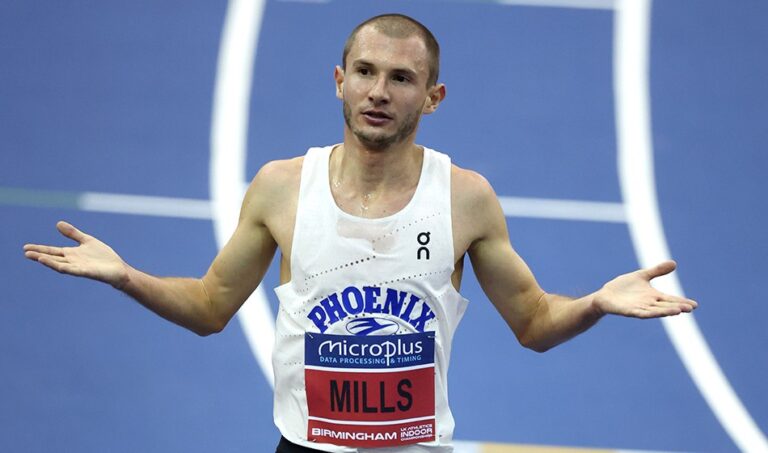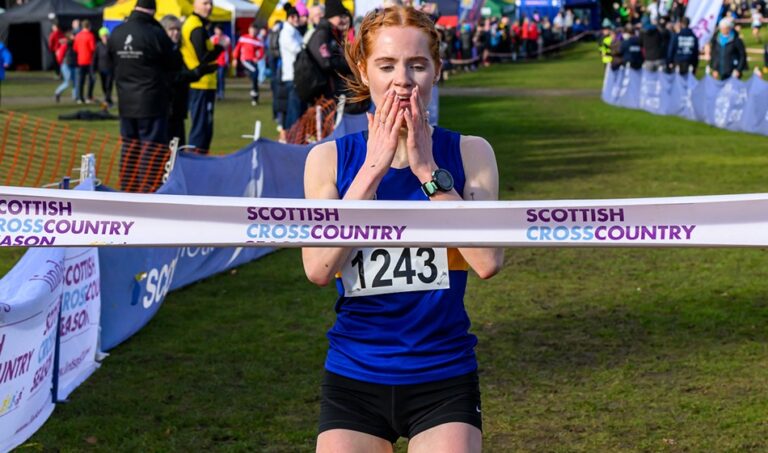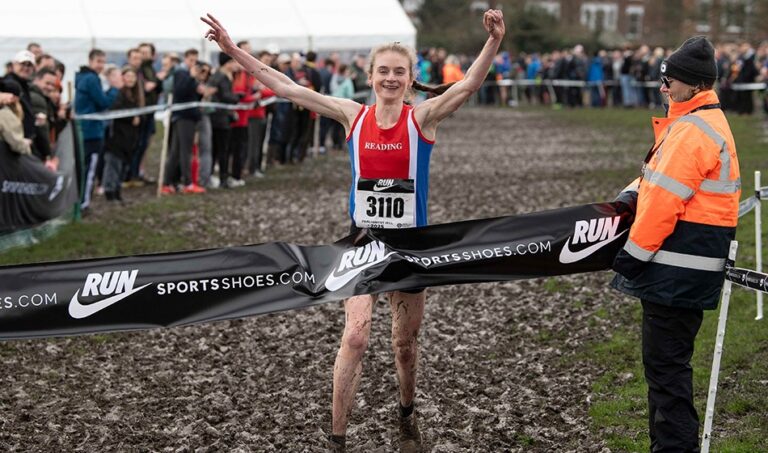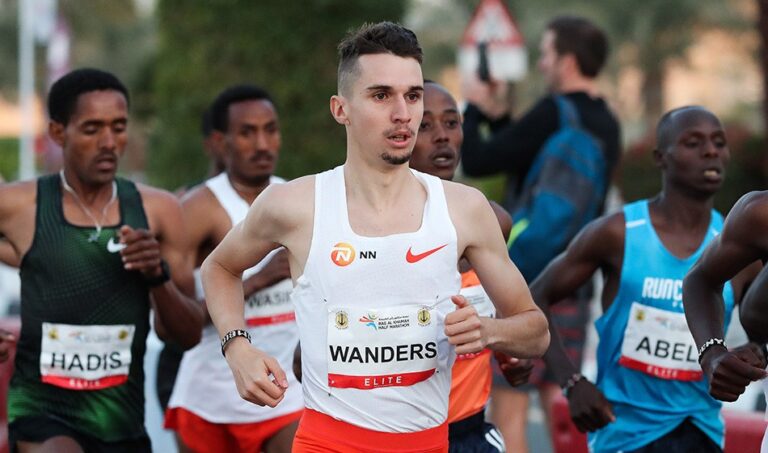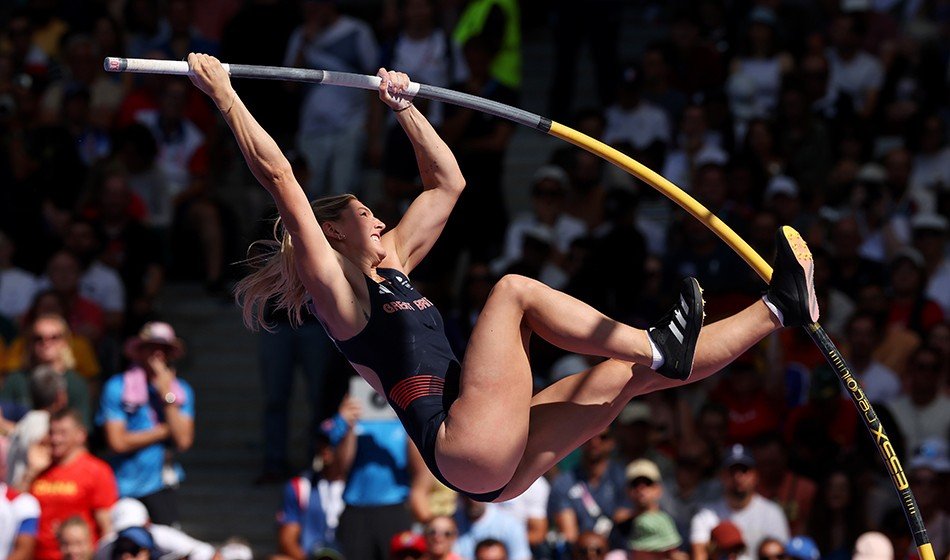
After her Olympic heartbreak last summer the world indoor champion explains why she is focusing instead on her rapid progress and aiming even higher in 2025
It would have been easy, and understandable, for Molly Caudery to allow herself to fixate on an Olympic opportunity missed. The pole vault heartbreak she suffered in Paris was particularly painful and still, she hasn’t figured out how or why it happened.
The 24-year-old arrived in the French capital as the world leader in her event with a height of 4.92m, as well as a world indoor title and European Championships bronze medal to her name. In other words, she was expected to be challenging for her sport’s greatest honour. Rather than put herself in podium contention, however, she failed to even make it beyond the qualifying stage in the Stade de France, unable to clear her opening bar of 4.55m – a task she would routinely complete in training.
Molly Caudery
Coping with such a blow was a challenge in itself but Caudery, a glass-half-full kind of athlete, instead chose to focus on the fact that so much went right in 2024. There were those championship medals to treasure, a British record to savour and the fact that no woman had jumped higher than she did last year.
It was 12 months that the Cornish athlete began to break through on the global scene and the events of last summer have only made her hungrier for more. She has lofty goals, in fact, for 2025.
Have you felt different as an athlete this winter, given that your base level went up so much in 2024?
Last year was my first winter where I’ve ever been healthy coming into the [new] year, which is why I think I was set up to have such a good year. This time I’ve also had another healthy winter and I’ve been more prepared for what I can do. I can train week on week and just build. This year my numbers are even better than last year.
Molly Caudery (Getty)
It was around this time last year that you started to make your big breakthroughs at the start of that indoor season.
I could not have asked for anything better. I was getting a PB almost every week and had the world lead. Then going and winning the World [Indoor] Championships… if someone had said that to me the previous December or even just before I was competing, I wouldn’t have believed them. It was just incredible and so much more than I thought I could have done. It all happened so fast, and it was [a case of] adapting to that but just enjoying it. I had the best time on the indoor circuit last year, so I’m excited to get to do it again.
Was it difficult to get going again this winter? You crammed just about every kind of experience – good and bad – you possibly could into the sporting year.
The disappointment of the Olympics almost made me hungrier so I couldn’t wait to get back to training. I did the Brussels Diamond League [a few weeks later], and that was a nice closure, but then I had my rest, and I was ready to get back to training. It’s what I love doing.
Is there a lingering frustration about the Olympics?
There’s a lingering frustration but I’m a lot more at peace with it than I was to begin with. It was almost like a grieving period. I had a great support team around me. I went home and, like I said, it just made me hungrier. After getting over the initial emotional side of things, it was just like: ‘Okay, now we need to get back to training and do what we can to not let that happen again’. It’s still something that I look back on, and it’s frustrating of course, but there’s nothing I can do about it, apart from training as hard as I can to put everything right so it doesn’t happen again.
Did you learn a lot about yourself through that process?
Yes, but the thing I think I’ve been struggling with most is that I still don’t know why it happened or what happened. It’s a conversation I’ve had many times with many people. I’ve been pushed to psychologists to try and figure it out.
But it was a bad day to have a bad day. People probably had no height during one competition a year, maybe, and that was the competition that it happened in. You have to take the positives from it, I guess, because otherwise, it seems a bit wasted and a bit pointless.

Molly Caudery (Getty)
Is it possible to explain what something like that feels like at the time?
I’ve spoken to a lot of people about this now, so it’s not something that I’ve held in. On my third attempt, when I was running down for that bar, in my mind there was no chance that I wasn’t going to clear it. I do it day in, day out in training so when the bar came down I was just in a state of shock. There was confusion, disbelief, all of those kinds of emotions. That took some time to get over, but I knew that it wasn’t [down to] my abilities. At my next competition, which was Brussels, I jumped 4.80m and I was kind of back to where I should be. There’s no real explanation for what happened. I can just learn from it and use it, but it’s a bit of a strange one still.
Was it a relief to clear that bar in Brussels, to confirm that you could still do this?
It was absolute closure. I was talking to some of the girls after and Nina Kennedy [gold medallist in Paris] was like: ‘It’s so brave of you to come back out’. A lot of people, after no-heighting at the Olympics, might have said: ‘Okay, I’m done for the season. Let’s just cap it’ but I just felt like I owed it to myself to go back out there and just show that I could do things.
That was necessary for me and it was a tough six weeks because I tore my calf a few days after the Olympics in a training session. That took ages to get better, and I kept trying to push to get back to competitions, and it would tear again and again. It was like the whole universe was telling me to stop but I was so adamant. After I competed in Brussels, my mind finally went a bit quiet, which was nice.

Molly Caudery (Diamond League)
What’s your schedule looking like for the rest of the indoor season?
(This interview happened before Caudery began the year by jumping 4.75m and then 4.73m at the Keely Klassic)
I’m probably competing more than I have ever done before, but we’re going to try and strategise competitions and just use each competition as training. I’m not as good in training as I compete when it comes to actual technical pole vaulting – I find it hard to get on bigger poles – so for me, competitions are a great bridge to get to the major championships because they allow me to use the extra stimulus and everything to jump higher.
The plan is to compete at the European and World Indoor Championships. I love the indoors. I had never competed abroad indoors before last year, and I went to France to do a few competitions, and they put on such great meets. For the championships, there’s just nothing like it. I think that’s what matters. Glasgow [the World Indoor Championships last year] was so much fun, so I’m excited to get to do it again.

Molly Caudery (Getty)
How much does that win still come back into your mind?
Quite often. With what happened at the Olympics, I try not to let that cloud the whole year, because it was an amazing year. I ended up being a world leader by the end of it, I broke the British record, I jumped over 4.90m and I won the World indoors. All of those moments, I try to think back to and remember, because it was such a special year. For the majority of it, I had so much fun, and that’s what I love doing. That’s why I do it.
What lies ahead this year must excite you, too, given how open the women’s pole vault is.
I’m so hungry for competition. I’m hungry to make a comeback. Some so many good girls are all pushing each other. For me, it’s: ‘Okay, I’ve jumped 4.92m, but my next bar would hopefully be five metres, and then the one after that would be attempting the world record [5.06m by Yelena Isinbayeva from 2009]’.
When you put it into that perspective it’s like: ‘Okay, we’ve got two bars to jump and then we’ve made it’ so that’s exciting. It’s not something that we think about too much but I’ve had conversations with my coach [about it]. Just to be having those conversations and having it in the back of my head is kind of surreal.
Five metres is a huge landmark for me. The last time someone jumped that height was in 2021 [5.01m by Anzhelika Sidorova] – and I would love to be the next person to do it. It’s definitely within my capabilities and I’m going to be competing a fair bit, so hopefully I’ll get the chance to give it a go.



